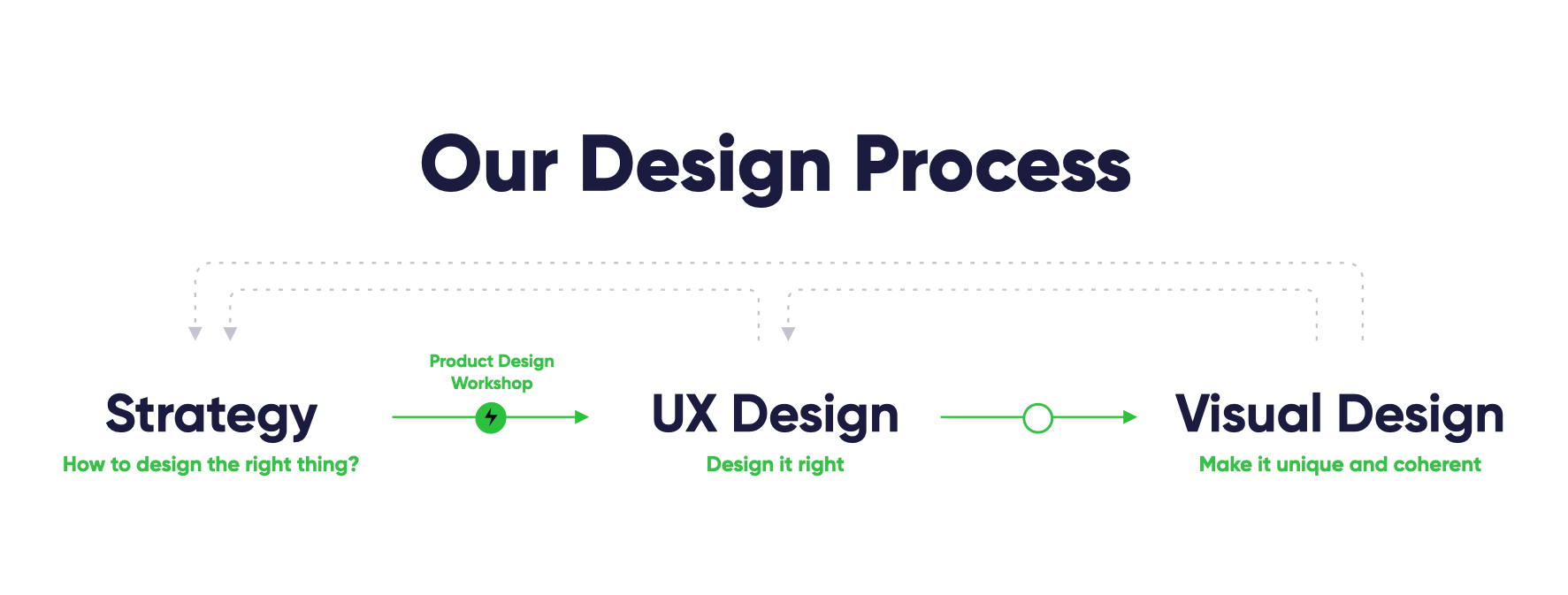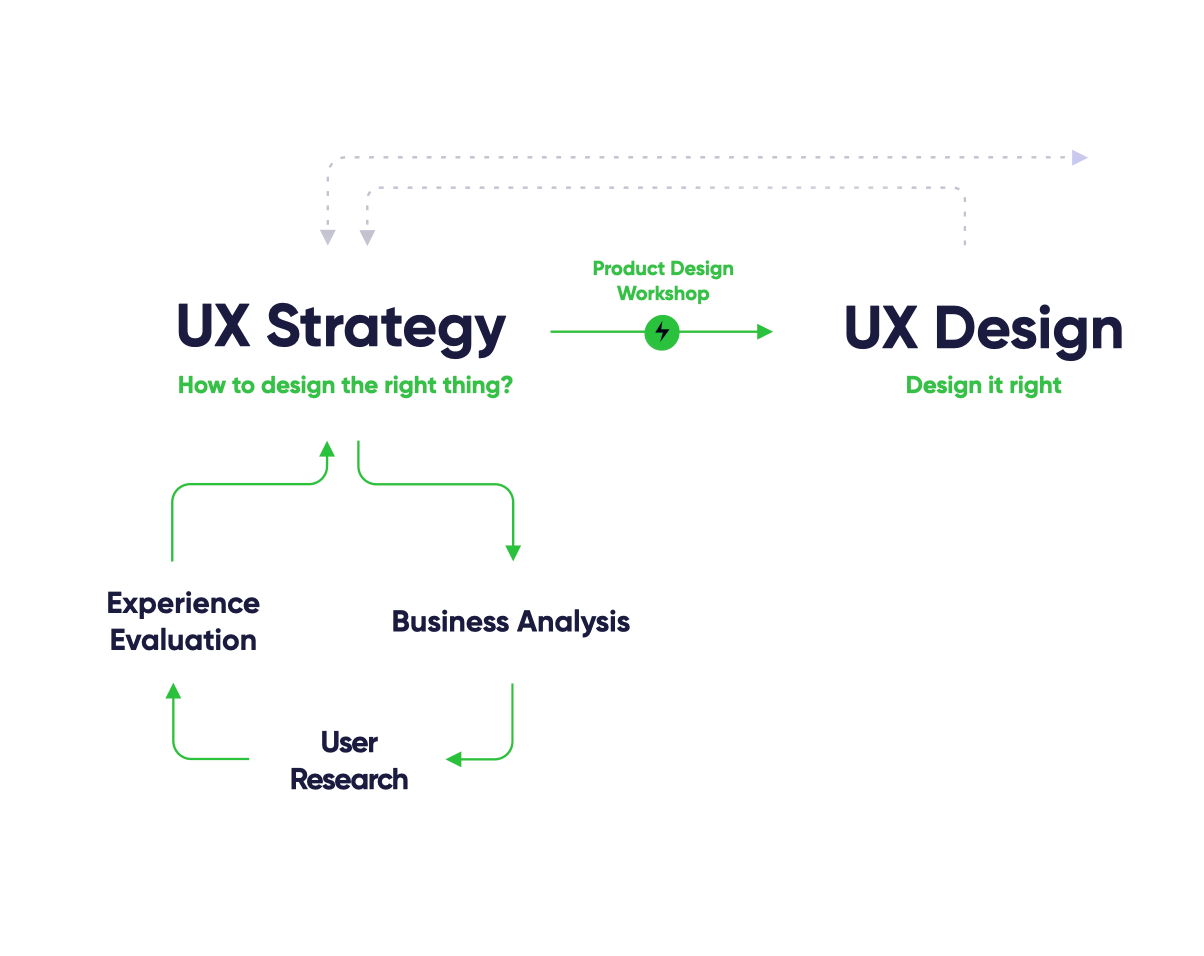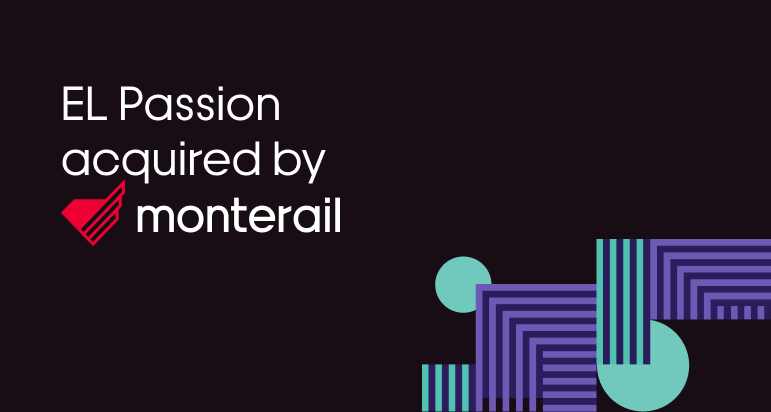26 May 2020 (updated: 16 July 2020)
Why a Brief is Not Enough of a Strategy For Your Digital Product
Chapters

And why you should spare the time for UX strategy before your app’s development.
“Would you tell me, please, which way I ought to go from here?”
“That depends a good deal on where you want to get to,” said the Cat.
“I don’t much care where–” said Alice.
“Then it doesn’t matter which way you go,” said the Cat."
Alice’s Adventures in Wonderland, Chapter 6
So you’ve decided to kickstart your very own digital product or the project you’ve worked so hard on has finally got a green light at your company. No matter which one it is, no matter the industry or the environment you’re working in, one thing stays the same: you need a solid plan.
Without a clear sense of direction, to quote the Alice-in-Wonderland’s Cat: it doesn’t really matter which way you go. And you don’t want a product that’s going nowhere.
A solid plan is a way to make sure the Cat’s advice won’t apply to you. And by a plan we actually mean a conscious design process guiding us (together) through every decision and with a defined goal above our heads, so we’re sure we stay on the right path.
This is you how you invalidate Alice-in-Wonderland-Cat’s advice, ladies and gentlemen.
“To build or not to build?” Or rather: WHAT & HOW to build should be the question!
“But I do already have a strategy for my digital product.”
You may ask — “Why bother? I do already have a strategy”.
Many digital product investors are eager to start the journey as soon as possible: they rush to see the first tangible results and keep it going forward. They decide to start with visual design, or even farther: move straight to the development, skipping the strategy phase entirely. But there are two things you ought to remember.
- Your design & development team needs to understand your vision to transform it into the right product that fits both: your users’ needs and your business goals.
- It is common that during our process stakeholders have time to discuss their general idea in-depth for the very first time. How the idea transfers into tangible app’s features? What elements are indispensable? And is it what users actually need? If there are more stakeholders on your side, potentially with a different vision, we can act as a moderator to help you prioritize and come up with the steps aligned with what you want to accomplish.
The path is our process. And it will save you quite a lot of money.
Software is much easier than, let’s say, real estate development. Before the construction company starts their work the only thing you can see is their plans and sketches. And without a somewhat vivid imagination, it might be difficult to picture the final effect.
When developing a digital product, we can prepare a mockup or a clickable prototype that shows you our concept and quickly make changes in case we depart from your original concept.
Iteratively agreeing on former steps does not only make the next steps easier but it also makes the development cheaper.
Changes in code are more time-consuming, so to put it bluntly: just more expensive.

- We start with UX Strategy and collectively define “how to design the right thing?”.
- We proceed with UX Design where we focus on designing the right thing in the right way.
- We finish with Visual Design to make the product look memorable, but more importantly, we make it accessible to your target audience.
These three steps, incorporated in each and every project, ensure that at the end of the day, you will reach the goal and the destination of creating a meaningful digital product.
- All stakeholders will share a common understanding of what is being built and will know how.
- The development team will know what they are expected to build.
- And last, but not least: the so-called surprise factor will be reduced to a minimum.
UX Strategy: how we focus on two aspects of the problem we aim to solve.
“UX strategy is the process that should be started first, before the design or development of a digital product begins. It’s the vision of a solution that needs to be validated with real potential customers to prove that it’s desired in the marketplace. (…) UX strategy is the “Big Picture.” It is the high-level plan to achieve one or more business goals under conditions of uncertainty.
Jaime Levy
There are two elementary requirements we make sure your product will meet:
- The customer-problem fit; we check if the problem you’re trying to solve is something your users are willing to pay for; or to put it bluntly, if your users will want to pay for the product you’re building.
- The problem-solution fit; we inspect if the core and the main concept of the product is a good enough answer to the problem. There might be many solutions, but not necessarily all of them will result in the same final success. Keep in mind that you define the goal and we see if the solution will take us there. But of course, if you’re hesitant about how to establish your goal metric, we’re happy to help you with that as well.
If we only have one process to fit all, one may ask, how can we cope with all those different business models and project stages?
Well, although the process is one, the methods we use vary depending exactly on the elements mentioned above.
As Jeff Bezos once put it — „We are stubborn on vision. We are flexible on details”.

For the UX Strategy phase, to make sure we will be designing the right thing, we will take you through the following steps using all the data you have already collected (about the market, about your users, about the organization system that will work in the background):
- Business Analysis: it is a moment where we bite into the business model behind the product and catch the bigger picture of your future market competitors. Methods: Business Model Canvas, Market Research, Competitors Analysis, UX Strategy Blueprint, Stakeholders Interviews, Internal Workshops and more.
- User Research: if none or some user needs research has been done before the project, we will suggest you the method that will allow us to check your concept in the most efficient way. Based on the gathered insights we will know how to offer the most value within the product and what key performance indicators should be on the spot when designing the product experience. Here’s a bunch of methods we use for that purpose: In-Depth Interviews (IDIs), Focus Group Interviews (FGIs) , Ethnographic Research, Desk Research, Netnography, Guerilla Research, Participatory observation, Kano Survey, Questionnaires, Dairy Studies, and many more!
- Experience Evaluation: for the cases when you already have a running piece of software that you want to expand, improve or slightly redesign we will start with an analysis of the current solution. Not only will it allow us to understand your business better and help us deliver expansion that will stay in line with your current solution, but also we may spot potential areas for improvement and make you a few suggestions. From our perspective, when supporting a product that already has been on the market, it is crucial to understand it with all humbleness, before we can offer you a new approach. Additionally, even if you do not have the product yet, we would advise you to conduct the experience evaluation on the product of your direct competitors — that way we would save time and money learning from their mistakes. Methods: Heuristic Evaluation, Web Analytics Analise, Usability Tests and Benchmarking.
The Product Design Workshop — it’s a wrap!
A Product Design Workshop is a checkpoint that will helps us close the UX Strategy phase and summarize and organize the findings before we go further.
During a Workshop, we all sit together to organize the data we gathered (the data you collected, the data we discovered for you).
We convert it all into actionable points: a product roadmap and the effort and impact map. These elements help us (you and our team) organize priorities for the next phase.
A Workshop can verify if you’re ready to take next steps with your idea. In our history, we’ve encountered projects that decided to fill in the blanks in their business canvas before going further.
If you’re interested to know the value behind a Workshop check out this short Workshop benefits round-up written by our Senior UX Designer, Michał Mazur.
UX Strategy phase is not a random walk in the park and it should end with tangible deliverables for your business.
We understand for whom we’ll building your product, we share the same goals and know the most important success metrics as well as possible technological limitations.
We know where we’re headed. The Cat has nothing on us now.
And this journey is to be continued: expect a second part explaining our UX design phase soon!





